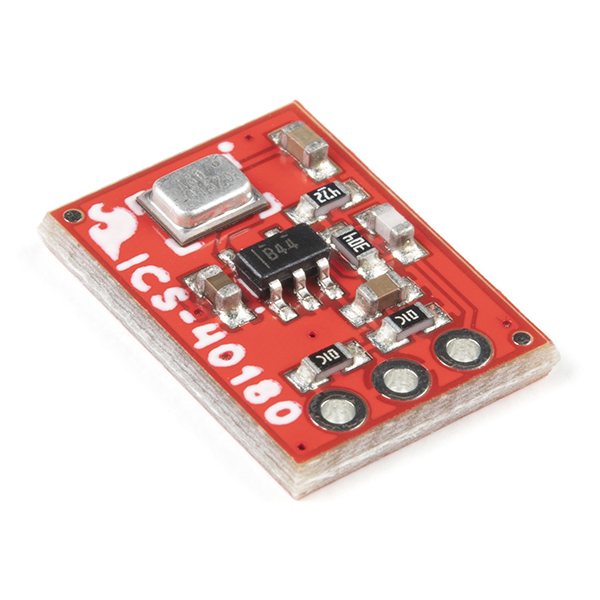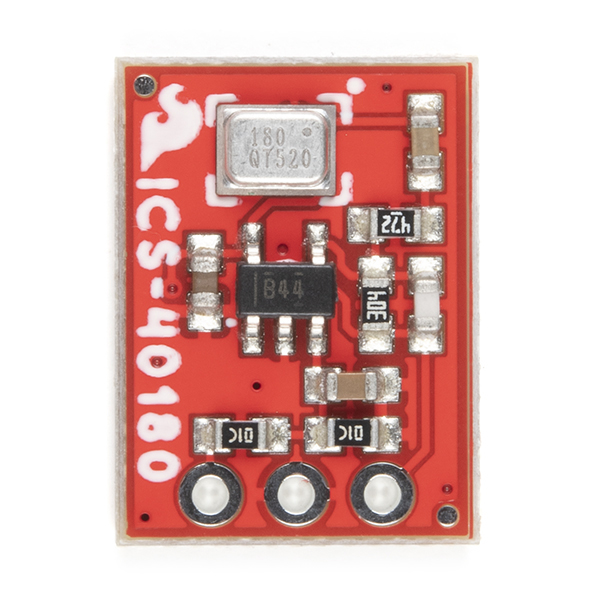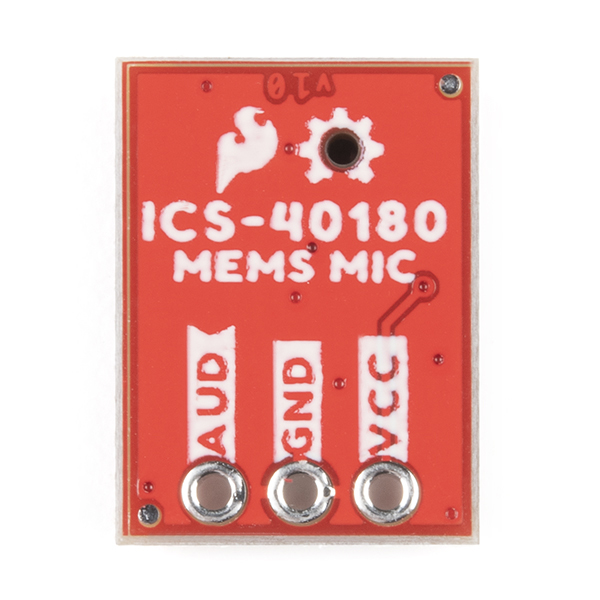SparkFun Analog MEMS Microphone Breakout - ICS-40180
The SparkFun Analog MEMS Microphone Breakout makes it easy to work with the InvenSense ICS-40180 analog microphone. This board features an OpAmp to bring the output of the microphone to a usable level, allowing you to plug directly into an ADC on a microcontroller or something like the SparkFun Spectrum Shield.
In addition to amplifying the signal, the OpAmp adds a bias voltage of 1/2 VCC. With sound sources such as a normal speaking voice a few feet away from the microphone, the AUD output signal will be at about 200mV peak-to-peak. Also note, this low profile microphone has its port on the bottom side, so the microphone can be mounted flush to the outer surface of your enclosure. This microphone is omni-directional, which means it does a good job of picking up sound sources from all directions.
- -3dB roll off at 60Hz and 19.7kHz
- 1.5VDC to 3.6VDC supply voltage
- Should comfortably output 40mW
- OPA344 provides 600Ω output impedance
- SNR of 65dBA
SparkFun Analog MEMS Microphone Breakout - ICS-40180 Product Help and Resources
MEMS Microphone Hookup Guide
January 27, 2017
Get started with the SparkFun analog MEMS microphone breakout board with Arduino! Create a volume unit meter with the ADMP401 or ICS-40180 to react to sound before building your sound visualizer!
Bark Back Interactive Pet Monitor
March 8, 2017
Monitor and interact with pets through this dog bark detector project based on the Raspberry Pi!
Audio Codec Breakout - WM8960 Hookup Guide
January 26, 2023
The SparkFun Audio Codec Breakout - WM8960 is a low power, high quality stereo codec chock full of features. In this tutorial, some of these features by using an Arduino microcontroller to configure the audio codec and pass audio to the headphone or speaker channels.
Core Skill: Soldering
This skill defines how difficult the soldering is on a particular product. It might be a couple simple solder joints, or require special reflow tools.
Skill Level: Noob - Some basic soldering is required, but it is limited to a just a few pins, basic through-hole soldering, and couple (if any) polarized components. A basic soldering iron is all you should need.
See all skill levels
Core Skill: Programming
If a board needs code or communicates somehow, you're going to need to know how to program or interface with it. The programming skill is all about communication and code.
Skill Level: Rookie - You will need a better fundamental understand of what code is, and how it works. You will be using beginner-level software and development tools like Arduino. You will be dealing directly with code, but numerous examples and libraries are available. Sensors or shields will communicate with serial or TTL.
See all skill levels
Core Skill: Electrical Prototyping
If it requires power, you need to know how much, what all the pins do, and how to hook it up. You may need to reference datasheets, schematics, and know the ins and outs of electronics.
Skill Level: Rookie - You may be required to know a bit more about the component, such as orientation, or how to hook it up, in addition to power requirements. You will need to understand polarized components.
See all skill levels
Comments
Looking for answers to technical questions?
We welcome your comments and suggestions below. However, if you are looking for solutions to technical questions please see our Technical Assistance page.
Customer Reviews
No reviews yet.





Any idea if it works above 20khz? Could this be used for listening to Bats? Thanks, Dom
Hi Dom, Sorry, but this mic's datasheet says it will only work from 60Hz to 20KHz. Also note, that the op amp design has an upper frequency -3dB roll off at 19.7KHz. Sounds like a cool project though. If you want to, you could try reaching out on our forums to see if anyone else might be able to recommend a mic with wider frequency response. https://forum.sparkfun.com/ Good luck! Pete
If I want to build a microphone array on a breadboard, should I let the side with the "hole" of the microphone up so the sound won't be blocked? Thanks!